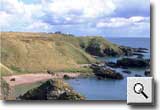|
|
|
| |
|
|
| |
Demolition of Slains Castle |
|
| |
| |
The
hamlet of Old Slains Castle taken at the end of
the 19th Century. The dominant feature of Old
Slains Castle is the ruined Norman Keep. Subsequently
owned by the Earl of Erroll, the castle was destroyed
by King James V1 of Scotland in 1594 to punish
the Earl for becoming involved in a Catholic plot
against him.
The houses seen clustered around the ruin were
largely abandoned in 1900 when the inhabitants,
following several seasons of poor fishing, voted
to move to seek their fortunes in Aberdeen.
|
|

|
| |
|
|
 |
| Smuggling |
| |
|
| |
| In
1707 the Excise duty on spirits was greatly increased
with the aim of putting spirits out of reach of
the lower classes. This, along with local Jacobite
sympathies, encouraged the smuggling of gin from
the Continent, mainly the Low Countries. The north
east of Scotland was ideally situated for this
smuggling trade, and in the late 18th and early
19th centuries Collieston became one of the main
centres for the landing of smuggled goods. Writing
in 1801 Collector Allardyce of Aberdeen Customs
described Collieston as ‘the principal haunt
of the smugglers for landing goods’, and
whose inhabitants were ‘ a turbulent riotous
pilfering set’. |
| |
PHILIP
KENNEDY |
| |
| Collieston’s
most famous smuggler is Philip Kennedy. He earned
his fame not through his exploits as a smuggler
but because of his courageous defence of his illicit
goods and his tragic death from a blow from a
custom’s cutlass. |
| |
| Phillip
Kennedy farmed at The Ward in the Parish of Slains.
On 19th December 1798 he and his brother John
had taken ashore at Cransdale 16 ankers of Holland
gin and with the help of servants were transporting
it to the Ward for concealment. They had only
travelled a short distance when the brothers were
challenged by a number of gaugers armed with cutlasses.
For arms the Kennedys had stout sticks weighted
with lead. In the fight that followed Phillip
tripped up two of the officers and held them down.
Meanwhile John had been wounded by a cutlass blow
to the head. The officer who inflicted this wound
then shouted on Phillip to release the two men
he was holding down but when Phillip refused to
do so the officer struck him on the head with
his cutlass splitting open his head. Phillip though
badly wounded staggered for almost a mile to the
farmhouse of Kirkton of Slains where he is reported
to have said before he died, “If a’
had bin as true as me the prize wid a bin safe
and widna bin bleedin tae death” The settle
on which he died is still in a house in the village. |
| |
Phillip
Kennedy’s grave can be seen on the right
hand side immediately you enter through the gate
into Slains Churchyard.
|
| |
|
|
|
| |
|
 |
|
| ....copyright
collieston's century 2003 |
|